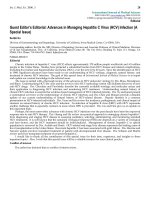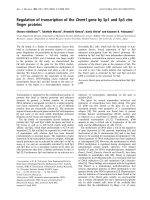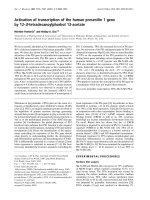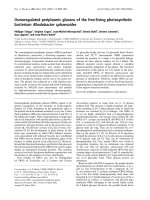Báo cáo y học: "Reshaping Cinderella’s slipper: the shared epitope hypothesis" docx
Bạn đang xem bản rút gọn của tài liệu. Xem và tải ngay bản đầy đủ của tài liệu tại đây (36.55 KB, 3 trang )
Page 1 of 3
(page number not for citation purposes)
Available online />Abstract
This issue of Arthritis Research and Therapy contains a succinct
and elegant paper by Michou and colleagues that advances our
understanding of the genetic basis of rheumatoid arthritis (RA) by
reclassifying the contribution of RA susceptibility alleles according
to their structure. This line of research is potentially important in our
conceptualization of the mechanism of disease in RA, in predicting
disease course and severity, and as a model for further studies on
this topic. The author’s approach to reassessing the molecular
structure of the shared epitope redirects attention to using the
binding properties of the major histocompatibility complex
molecules associated with susceptibility to search for the peptides
driving the autoimmune process underlying rheumatoid arthritis
This issue of Arthritis Research and Therapy contains a
succinct and elegant paper by Michou and colleagues [1]
that advances our understanding of the genetic basis of RA
by reclassifying the contribution of RA susceptibility alleles
according to their structure. This line of research is potentially
important in our conceptualization of the mechanism of
disease in RA, in predicting disease course and severity, and
as a model for further studies on this topic.
More than 10 different HLA-DRB alleles predispose to the
development of rheumatoid arthritis (RA) and this number
alone distinguishes RA from many other autoimmune
diseases. Over two decades ago the existence of common
structural features of the HLA-DR4 and DR1 molecules
encoded by these multiple susceptibility alleles emerged from
pioneering sequencing efforts and this structure was termed
the shared epitope (SE) [2]. The SE hypothesis was a simple
conceptual framework that sought to redirect thinking about
disease susceptibility towards a unifying molecular
susceptibility structure that would aide in the search for
peptides driving the T cell immune response underlying RA, a
sort of Cinderella’s slipper. The original notion of SE was
modified by the concepts of protective alleles [3] and
‘homozygosity’ or allelic interaction [4]. Additional support for
the SE hypothesis came from other unrelated alleles in
different populations that encode a SE motif that were
identified as RA susceptibility alleles, for example,
DRB1*1402 [5] and DRB1*1001 [6].
Although a Google search reveals over 40,000 hits for
‘shared epitope’, reflecting the efforts by many to advance RA
genetics, both knowledge of the inciting peptide, and how
the nature and conformation of the peptide-binding groove
predispose to RA eludes our grasp. Difficulties in identifying
which alleles are implicated in RA susceptibility or protection
and which regions of molecules encoded by these alleles are
functionally important has resulted in several different allele
classifications that yield contrasting notions of the shape and
significance of a unifying molecular structure. Indeed, using
some of these classifications, the question has been raised
whether the so-defined SE concept is correct.
The study of Michou and colleagues [1] began with Tezenas
du Montcel and colleagues [7], who rejected the then current
view of the contribution of various alleles to the SE as not
fitting observed RA inheritance and proposed a new
classification of the SE: S1 alleles, for example, DRB1*0402,
where negatively charged glutamic acid (E-R-A-A), negates
the susceptibility effect of the R-A-A motif; S2 alleles
associated with highest disease susceptibility, for example,
DRB1*0401 and *1303, with lysine (K-R-A-A) that are
independent of the residue at position 70; and S3 arginine
(R-R-A-A), further subdivided according to position 70 into
R/Q-R-R-A-A S3P alleles associated with intermediate
susceptibility to RA, including DRB1*0101, *0102, *0404,
*0405, *0408, *1001 and *1402 and S3D alleles including
DRB1*1101, and *12 with the D-R-R-A-A motif. Important
features of this new classification include: the distinction of
the S1 and S3D, allowing study of their protective effect;
elimination of the influence of the glycine/valine polymorphism
at position 86, thereby reducing the number of SE
Commentary
Reshaping Cinderella’s slipper: the shared epitope hypothesis
Robert Winchester
Departments of Medicine, Pediatrics and Pathology, Columbia University, New York, NY 10032, USA
Corresponding author: Robert Winchester,
Published: 22 May 2006 Arthritis Research & Therapy 2006, 8:109 (doi:10.1186/ar1970)
This article is online at />© 2006 BioMed Central Ltd
See related research article by Michou et al., />MHC = major histocompatibility complex; OR = odds ratio; RA = rheumatoid arthritis; SE = shared epitope.
Page 2 of 3
(page number not for citation purposes)
Arthritis Research & Therapy Vol 8 No 3 Winchester
categories; and reclassification of alleles, notably DRB1*1303,
a K-R-A-A allele, as a S2 allele. X alleles lack the SE motif.
The predictive power of this SE classification to identify RA
susceptibility was cross-validated in this report by Michou
and colleagues [1].
What sets this study [1] apart is that the cross validation
experimental design and statistical analysis embody
thoughtful and powerful contemporary approaches that
should become the norm in this field. This transmission
disequilibrium study design has a marked advantage over
case-control designs when dealing with major
histocompatibility (MHC) loci because the extremely
polymorphic alleles increase the ever-present risk of ethnic
stratification in independently selected control groups.
The paper confirmed that the weight of contribution to RA
susceptibility is not equal for each SE virtual allele. S2 and
S3P respectively confer high or moderate risk for RA, while X,
S1 and S3D do not influence risk and were grouped together
as L alleles. The high risk SE conformation of the K-R-A-A
motif is independent of the contribution of position 70, while
the lower risk R-R-A-A motif (e.g. in DRB1*0101 or *0404
Q-R-R-A-A) is strongly influenced by the charge of position
70. The work strongly confirms that virtual genotypes
involving certain SE combinations differ in the risk they
contribute to the development of RA. S2/S3P and S2/S2 in
grouped analysis provide remarkably high risks (odds ratios
(ORs) 22.2 and 20.5, respectively). The other three
genotypes confer lower risks: S3P/S3P, OR 8.7; S2/L, OR
5.3; and S3P/L, OR 3.1. The two levels of risk suggest that
two differing disease mechanisms operate and that epistatic
interactions with other non-MHC genes might preferentially
occur with only one of these. In the ‘hemizygous’ situation of
S2/X or S3P/X, the SE acts like a conventional dominant
immune response gene in regulating peptide binding. Why
certain compound SE genotypes provide a multiplicative risk
over single alleles or their attendant haplotypes is harder to
explain. Some of these allelic combinations have previously
been associated with vasculitis [4,6,8], suggesting the new
classification will better predict those likely to develop more
severe disease, which could require more intense therapy.
Michou and colleagues did not obtain evidence supporting a
protective effect for S3D or S1 alleles, although this might be
due to their lower frequency in this particular study
population. The new classification provides a clear approach
for additional studies to examine the apparent protective
effect of S1 and S3D virtual alleles reported in some studies
[3]. While the paper of Michou and colleagues [1] was in
press, another report appeared by Gourraud and colleagues
[9], also demonstrating that the classification proposed by
Tezenas du Montcel and colleagues [7] was also superior to
older classifications of SE alleles in predicting radiological
progression to erosive disease and also supporting the
identification of a protective effect on progression. This cross-
sectional study from Toulouse in Southern France used a
Midi-Pyrenees patient population exhibiting a rather different
composition of HLA-DR alleles, presumably reflecting
Basque and Mediterranean influences; for example, S2 allele
frequency increased from 9 to 21.5 and X alleles decreased
from 36% to 19.4% compared to the study of Michou and
colleagues [1]. Notably, a protective role was identified for
S3D alleles on progression to erosive disease. However, the
cross-sectional study design format limited the conclusions
that could be made concerning genetic susceptibility and
protection.
The triad study design of Michou and colleagues [1],
requiring both parents to be typed, necessarily included
younger age onset RA (31 ± 9 years). This appears to have
selected a distinctive study population as there was a marked
female preponderance (90%), and rheumatoid factor
detectable in 76% of subjects, nodules in 19% and erosions
in 79%, indicative of classic, severe RA. This of course raises
the old and unanswered question of whether the current
syndromic classification criteria for RA are non-specific and
whether anti cyclic-citrullinated peptide (CCP) antibody-
negative and rheumatoid factor-negative patients with non-
erosive arthritis who are SE-negative might contain a large
proportion of individuals with milder arthritis of an etiology
different from RA.
The Michou and colleagues report is a major advance and a
template for future studies, but there is still insufficient
information to develop a comprehensive conformational
understanding of how the DRB1 molecules confer RA
susceptibility in terms of motif, charge and other properties of
the amino acids and whether this implies two or more
conformations that bind different peptides. The exact shape
of the glass slipper still eludes us. Studies in populations in
addition to French Caucasoids that have differing frequencies
of susceptibility alleles or potentially protective alleles are
necessary to refine the SE model by addressing questions
such as the contribution to the SE of DRB1*0901 or *0411
that have RAE motifs and the role of ARAA motif alleles. As of
April 2006, there are some 522 HLA-DRB alleles, so there is
still much to discover about their role in RA.
Of course, the MHC is characterized by its haplotypic
organization and the pervasive linkage disequilibrium among
various alleles of the MHC loci and non-DRB1 alleles in
linkage disequilibrium with DRB1 alleles also contribute to
RA susceptibility, as emphasized by Jawaheer and colleagues
[10]. This SE classification, by pointing out that different
haplotypes encode a structure that may make them identical
by state, and that the inheritance of two SEs confers
multiplicative risk, directs attention to a different, more
functional axis on which to conceptualize and model the role
of the MHC gene effect. Indeed, stratification of patients
according to SE genotype may facilitate better identification
and analysis of haplotype specific effects. Challenged by this
Page 3 of 3
(page number not for citation purposes)
new classification of RA susceptibility alleles [1] and in
concert with the efforts of major genomic consortia focused
on RA, one senses we are poised for a period of very fruitful
insight into this enigmatic disease.
Competing interests
The author declares that he has no competing interests.
References
1. Michou L, Croiseau P, Petit-Teixeira E, du Montcel ST, Lemaire I,
Pierlot C, Osorio J, Frigui W, Lasbleiz S, Quillet P, et al: Valida-
tion of the reshaped shared epitope HLA-DRB1 classification
in rheumatoid arthritis. Arthritis Res Ther 2006, 8:R79.
2. Gregersen P, Silver J, Winchester R: The shared epitope
hypothesis: An approach to understanding the molecular
genetics of susceptibility to rheumatoid arthritis. Arthritis
Rheum 1987, 30:1205-1213.
3. van der Helm-van Mil AH, Huizinga TW, Schreuder GM, Breed-
veld FC, de Vries RR, Toes RE: An independent role of protec-
tive HLA class II alleles in rheumatoid arthritis severity and
susceptibility. Arthritis Rheum 2005, 52:2637-2644.
4. Weyand CM, Xie C, Goronzy JJ: Homozygosity for the HLA-
DRB1 allele selects for extraarticular manifestations in
rheumatoid arthritis. J Clin Invest 1992, 89:2033-2039.
5. Willkens RF, Nepom GT, Marks CR, Nettles JW, Nepom BS:
Associations of HLA-Dw16 with rheumatoid arthritis in
Yakima Indians. Further evidence for the "shared epitope"
hypothesis. Arthritis Rheum 1991, 34:43-47.
6. Winchester R: The molecular basis of susceptibility to
rheumatoid arthritis. Adv Immunol 1994, 56:389-466.
7. du Montcel ST, Michou L, Petit-Teixeira E, Osorio J, Lemaire I,
Lasbleiz S, Pierlot C, Quillet P, Bardin T, Prum B, et al: New clas-
sification of HLA-DRB1 alleles supports the shared epitope
hypothesis of rheumatoid arthritis susceptibility. Arthritis
Rheum 2005, 52:1063-1068.
8. Gorman JD, David-Vaudey E, Pai M, Lum RF, Criswell LA: Partic-
ular HLA-DRB1 shared epitope genotypes are strongly asso-
ciated with rheumatoid vasculitis. Arthritis Rheum 2004, 50:
3476-3484.
9. Gourraud PA, Boyer JF, Barnetche T, Abbal M, Cambon-Thomsen
A, Cantagrel A, Constantin A: A new classification of HLA-DRB1
alleles differentiates predisposing and protective alleles for
rheumatoid arthritis structural severity. Arthritis Rheum 2006,
54:593-599.
10. Jawaheer D, Li W, Graham RR, Chen W, Damle A, Xiao X, Mon-
teiro J, Khalili H, Lee A, Lundsten R, et al: Dissecting the genetic
complexity of the association between human leukocyte anti-
gens and rheumatoid arthritis. Am J Hum Genet 2002, 71:585-
594.
Available online />









